Weatherford Hammond Award Winning Paper by Takudzwa Madvuta
While breadlines elongated perpetually during the 1930s, the proliferation of the Mammy stereotypes 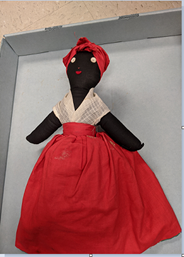 and the Appalachian Craft Revival were at their peaks. The production of Missy n’ Mammy by the Fireside industries under the leadership of Anna Ernberg, circa the late 1930s, represents these peaks (Figure 1).[1] The first time I saw Missy n’ Mammy was at an exhibit by the Appalachian Studies’ Collection Center with a group of weavers. When everyone saw the doll, a plethora of vulgar comments came out from the weavers, complaining about how insensitive this rag doll was to the African American population.
and the Appalachian Craft Revival were at their peaks. The production of Missy n’ Mammy by the Fireside industries under the leadership of Anna Ernberg, circa the late 1930s, represents these peaks (Figure 1).[1] The first time I saw Missy n’ Mammy was at an exhibit by the Appalachian Studies’ Collection Center with a group of weavers. When everyone saw the doll, a plethora of vulgar comments came out from the weavers, complaining about how insensitive this rag doll was to the African American population.
Despite feeling those emotions as well, I wondered if I would react the same had I been steeped in the visual culture of the 1930s. I also wondered if I would have succumbed to the visual culture that demanded derogatory images like Missy n’ Mammy. In this paper, I argue that Anna Ernberg’s 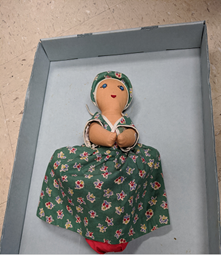 Swedish background, Appalachian Craft Revival, and visual culture influenced Ernberg’s production of Missy n’ Mammy during the 1930s, challenging her feminist efforts. To progress this argument, I asked the following questions. What did the Mammy-stereotyped doll mean for black and white female bodies, and did the production of the Miss n’ Mammy monumentalize this meaning? How influential were the demands of the Appalachian Craft Revival and visual culture on Ernberg’s production of Missy n’ Mammy, did it also represent the influence of her peers?
Swedish background, Appalachian Craft Revival, and visual culture influenced Ernberg’s production of Missy n’ Mammy during the 1930s, challenging her feminist efforts. To progress this argument, I asked the following questions. What did the Mammy-stereotyped doll mean for black and white female bodies, and did the production of the Miss n’ Mammy monumentalize this meaning? How influential were the demands of the Appalachian Craft Revival and visual culture on Ernberg’s production of Missy n’ Mammy, did it also represent the influence of her peers?
At first glance, the production of the Missy n’ Mammy confirmed the efforts of the Appalachian Craft Revival, which sought to promote the restoration of lost colonial art, while increasing the self-efficacy of the craft artists who made these artworks. It was a lament from Lost Cause preservers who feared that the culture of the second wave of  western Europeans would taint lost colonial art. [2] The Lost Cause was a belief adopted after the civil war, painting the Confederates’ war efforts as brave and honorable.[3] This belief praised Southern lifestyle and culture before the civil war, claiming that slaves were content with plantation life. Thus, Missy n’ Mammy achieved the goals of the Appalachian Craft Revival by providing jobs for the weavers who made these dolls and by perpetuating a stereotype connected with the colonial Mammy and the Southern Belle.[4]
western Europeans would taint lost colonial art. [2] The Lost Cause was a belief adopted after the civil war, painting the Confederates’ war efforts as brave and honorable.[3] This belief praised Southern lifestyle and culture before the civil war, claiming that slaves were content with plantation life. Thus, Missy n’ Mammy achieved the goals of the Appalachian Craft Revival by providing jobs for the weavers who made these dolls and by perpetuating a stereotype connected with the colonial Mammy and the Southern Belle.[4]
The Southern Belle was a stereotype used for southern women whose upper socioeconomic class, was identified by their trendy dressing, sexual innocence, and passion.[5] Even though it developed in the 1850’s, its proclivity to female suppression is seen in the 1930s in fictional characters like Scarlett O’Hara in Gone with the wind film.[6] It is also seen in the Missy side of Missy n’ Mammy as they both are fashionable and do not suggest sexual immorality.[7] Both are symbols of the Lost Cause rhetoric that promoted plantation life.
Through the inclusion of the Missy side, Missy n’ Mammy symbolizes unity between black and white women striving to gain rights like equal pay. However, the difference between the treatments of the doll sides leans towards the class difference between black and white women. The juxtaposition of the Missy’s blue-eyes and white skin, suggesting its Anglo-Saxon ancestry, against the Mammy’s bulging eyes and black skin, proclaiming the demeaning Mammy stereotype, showcase class difference.[8] Moreover, the types of headwear worn by the dolls signify this class difference. While the Missy side wears a decorated green bonnet, signifying the Southern Belle, the Mammy wears a kerchief, indicative of domestic worker uniform at the time.[9]
The use of Missy n’ Mammy as a nurturing teacher and a storytelling assistant sheds light on the reasons why black women could not pass through the line that class differences had created.[10] As benign as it was to teach children to take care of objects living and non-living, the class difference taught by dolls like Missy n’ Mammy progressed from generation to generation. It is this act of taking care of Missy n’ Mammy, that fed the faithful slave rhetoric found in the Lost Cause doctrine that claimed that the Confederacy’s reasons to enter the civil war were just and heroic.
This faithful slave rhetoric rose to fame during the Great Depression and the Jim Crow eras when the Southerners’ fetish of an imagined past filled with content and faithful slaves was at its peak.[11] This nostalgia was translated to black domestic subservience as represented by Missy n’ Mammy, resulting in generations of white girls who would later want a Mammy of their own. To the generation of black girls whose mothers wore this stereotype as domestic workers, it deflated their hopes of becoming more than just a Mammy in a country that was hungry for them.[12] However, for others, it motivated them to become more than just a stereotyped domestic worker, as seen in the actress Hattie McDaniel.[13]
As Missy n’ Mammy’s contemporary, Hattie McDaniel’s Oscar-winning performance as Mammy in the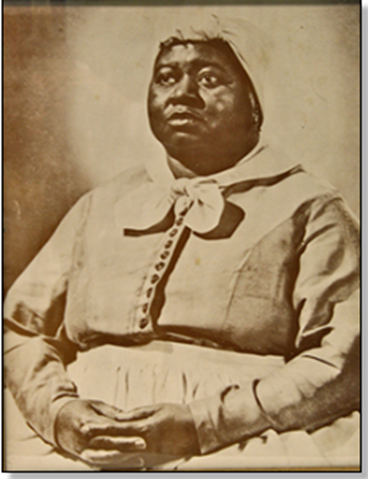 film Gone with the wind serves as a living monument to the Lost Cause doctrine that supported the “faithful servant” rhetoric.[14] Although her mother’s job as a domestic worker motivated her to pursue entertainment, the Mammy stereotype followed her in Gone with the wind (Figure 2). However, even after following her, McDaniel’s reinterpretation of the Mammy stereotype as:
film Gone with the wind serves as a living monument to the Lost Cause doctrine that supported the “faithful servant” rhetoric.[14] Although her mother’s job as a domestic worker motivated her to pursue entertainment, the Mammy stereotype followed her in Gone with the wind (Figure 2). However, even after following her, McDaniel’s reinterpretation of the Mammy stereotype as:
… an opportunity to glorify Negro womanhood-not the modern, stream-lined type of Negro woman who attends teas and concerts in ermine and mink- but the type of Negro of the period which gave us Harriet Tubman, Sojourner Truth, and Charity Still. The brave, efficient, hard-working type of womanhood which has built a race, mothered our Booker T. Washington, George W. Carver, Robert Moton, and Mary McLeod Bethune. So, you see, the mothers of that era must have had something in them to produce men and women of such caliber.[15]
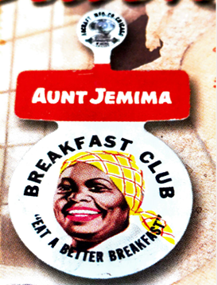 Unlike Hattie McDaniel, Missy n’ Mammy’s ornate contemporaries only had one dominant interpretation of the Mammy stereotype, which fueled white paternalism towards black domestic women. Mammy-stereotyped objects like Aunt Jemima pancake flour, Fun-To-Wash, Ole Mammy shortening, conjured black servitude nostalgia, giving the white employer the right to be paternalistic toward black domestic women (Figure 3).[16] Prevalent at the time, the employers paid their black domestic workers with clothes or food instead of money, believing that money would disturb the master-faithful servant relationship that was in their imagination. Even poverty-stricken white families sacrificed their possessions for black domestic workers to feed their paternalistic ambitions and to maintain social status in the community.[17]
Unlike Hattie McDaniel, Missy n’ Mammy’s ornate contemporaries only had one dominant interpretation of the Mammy stereotype, which fueled white paternalism towards black domestic women. Mammy-stereotyped objects like Aunt Jemima pancake flour, Fun-To-Wash, Ole Mammy shortening, conjured black servitude nostalgia, giving the white employer the right to be paternalistic toward black domestic women (Figure 3).[16] Prevalent at the time, the employers paid their black domestic workers with clothes or food instead of money, believing that money would disturb the master-faithful servant relationship that was in their imagination. Even poverty-stricken white families sacrificed their possessions for black domestic workers to feed their paternalistic ambitions and to maintain social status in the community.[17]
The proliferation of the Mammy stereotype in a society where black and white people excused these derogatory images as mediums to educate the viewer of different black identities is not shocking.[18] Although white people mostly imposed the black stereotypes, African American critics like W.E. Du Bois praised Mammy-stereotyped paintings like Palmer Hayden’s Midsummer nights in Harlem for their New Negro representation. Thus, Missy n’ Mammy perpetuated numbness to the harmful effect of these stereotypes on black self-perception.
The presence of such a doll in an interracial school like Berea College, during President Frost’s era, is also not startling as the 1904 Day Law was signed into the Commonwealth of Kentucky laws prohibiting interracial education in Kentucky schools. This act disrupted the Berea’s commitment to educating all races, resulting in its segregation to form the Lincoln Institute, which allowed the college to continue providing education to all races.[19] It was an act that Thus, the absence of African Americans licensed the production of such stereotypes. Not only did Fireside industries produce Missy n’ Mammy, but Ernberg also led the women into making other similar dolls like Mammy, Dinah, Sambo, and Petunia (Fig 4&5). Unlike Missy n’ Mammy, these dolls received more demeaning descriptions in the catalogs, like Dinah’s “fat and happy” description. Missy n’ Mammy was also unique in that it had the Missy side, which could explain why the doll’s description was not as harsh, as it could have been an effort to respect the Missy side.[20]
also not startling as the 1904 Day Law was signed into the Commonwealth of Kentucky laws prohibiting interracial education in Kentucky schools. This act disrupted the Berea’s commitment to educating all races, resulting in its segregation to form the Lincoln Institute, which allowed the college to continue providing education to all races.[19] It was an act that Thus, the absence of African Americans licensed the production of such stereotypes. Not only did Fireside industries produce Missy n’ Mammy, but Ernberg also led the women into making other similar dolls like Mammy, Dinah, Sambo, and Petunia (Fig 4&5). Unlike Missy n’ Mammy, these dolls received more demeaning descriptions in the catalogs, like Dinah’s “fat and happy” description. Missy n’ Mammy was also unique in that it had the Missy side, which could explain why the doll’s description was not as harsh, as it could have been an effort to respect the Missy side.[20]
 The production and sale of Missy n’ Mammy and her contemporaries would not have been possible without the leadership of Anna Ernberg. Ernberg moved from Sweden to the U.S. with her husband, Hjalmar Ernberg, and two sons in 1898 (Fig 6). When Ernberg arrived in New York, her prior experience from the Normal School of Sweden and Art and Sloyd School, propelled her to become a textile and hand weaving teacher at the Pratt Institute and later Teachers College of Columbia University until 1911.[21] Ernberg was hired by William G. Frost as the Director of Berea College’s Fireside Industries from 1911 to 1936 and died on April 1, 1940, from an extended heart illness.
The production and sale of Missy n’ Mammy and her contemporaries would not have been possible without the leadership of Anna Ernberg. Ernberg moved from Sweden to the U.S. with her husband, Hjalmar Ernberg, and two sons in 1898 (Fig 6). When Ernberg arrived in New York, her prior experience from the Normal School of Sweden and Art and Sloyd School, propelled her to become a textile and hand weaving teacher at the Pratt Institute and later Teachers College of Columbia University until 1911.[21] Ernberg was hired by William G. Frost as the Director of Berea College’s Fireside Industries from 1911 to 1936 and died on April 1, 1940, from an extended heart illness.
Frost’s hiring of Ernberg stems from his prioritization of Appalachian culture and the welfare of its people, resulting in the Fireside industries, which helped provide jobs and income to Appalachian women.[22] Thus, Frost wanted a leader who had the passion, skill, market knowledge, and a business-mind, resulting in the hiring of Ernberg.[23] Due to the influx of Swedish immigrant-weavers like Ernberg, Frost advised Ernberg only to teach Appalachian women regional weaving patterns and products, including defamatory images like Missy n’ Mammy.[24]
Thus, Ernberg’s participation in the production of Missy n’ Mammy suggests her adaptation to the Appalachian visual culture, which President Frost fostered. Ernberg could have adapted to Frost’s regionalism to keep the Fireside Industries in business.[25] Thus, Frost’s artistic suppression of Ernberg’s Swedish was an influence in the production of Missy n’ Mammy.
However true this might be, as the Director of the Fireside industries, Ernberg had the right to choose which type of lost colonial art she would design into a product.[26] Ernberg knew of the Berea College’s interracial precepts and thus had the authority to choose whether to honor these precepts or deface them. There is also no correspondence between President Frost and Ernberg that suggests that Frost mandated Ernberg’s decision to make these derogatory images.
Missy n’ Mammy signifies Anna Ernberg’s cognitive dissonance, as seen on the Missy side that symbolizes her efforts to progress the estate of unemployed Appalachian women and on the Mammy side, which shows how she participated in womanhood minstrelsy.[27] To the onlooker, Ernberg fought women’s rights by providing jobs for community women and students. As a spokesman, Ernberg marketed products and the need for donations through speeches and articles distributed to buyers on her sales trips, to keep the weavers employed.[28] As a leader, she taught other women how to initiate and manage their weaving schools like Lucy Morgan, a student who started the Penland School of Crafts.[29] As a designer, Ernberg designed a small hand loom in 1913, inspiring other women’s creativity.[30] Overall, Ernberg is viewed as a champion for women’s rights.
Nevertheless, when Ernberg’s studio working environment and marketing schemes are considered in addition to the production of stereotyped dolls like Missy n’ Mammy, this view is challenged. Ernberg was known for being uncooperative to both her employers and employees, and even though this kept her production levels high, her employees can attest to a toxic working environment.[31] One example is an incident where Ernberg replaced Julia Smith’s weaving job after the employee begged her to save her job after her vacation. From this incident, Smith’s replacement could have been caused by Ernberg’s need to keep production levels high.[32] However, if this was the case, Ernberg should have welcomed Smith back after the break, which she did not.
Additionally, Ernberg’s marketing scheme often portrayed Appalachian women as ignorant and weak, to gain buyers who bought Fireside products to protect colonial tradition from mingling with immigrant culture. Ernberg’s articles like They have eyes and see not, they have ears but do hear not, and news articles confirmed her condescending view of the Appalachians, which she claims to have made “more American” (Fig 7).[33] Economically, the Fireside industry products would not have high sales, without this demeaning portrayal’s appeal to lost cause preservers. This thought might be relevant yet, Ernberg continued to depict Appalachian women as uneducated and poor well after the Fireside industries had become stable enough to deserve a better portrayal.[34]
Missy n’ Mammy also represents the influence of Enberg’s peers who furthered the Appalachian Craft Revival either for the restoration of lost colonial art or their capitalistic interests. One of Ernberg’s peers who progressed the Appalachian Craft revival for the restoration of lost colonial art was Eleonor Roosevelt, who, like Ernberg, was the leader of craft programs. Together with her co-founders Marion Dickerman and Nancy Cook, Roosevelt established a furniture-making shop called Val-Kill Industries in 1926 and later supervised the Arthurdale experiment.[35] Just like Ernberg, Roosevelt fought for the inclusion of government-funded craft programs, despite the government’s suspicion of the presence of socialism in these programs.[36] Unlike Ernberg, Roosevelt supported black artist and their works instead of making stereotyped images of them.[37]
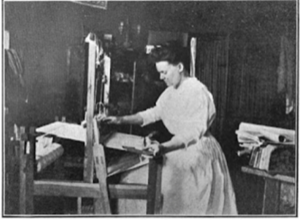
Anna Ernberg 1911
The lost cause preservers often were at odds with Ernberg’s peers who prioritized the profitability of the crafts sold, representing Ernberg’s capitalistic ambitions. Although Ernberg was not a businesswoman by training, she knew how to appeal to the market just like her peers.[38] These intentions were also present in the Southern Highlands Handicraft Guild leaders like Isadora Williams, who emphasized the making of craft products “like the person who buys it likes it.”[39] Thus, Ernberg’s peers influenced her production of dolls like Missy n’ Mammy as the doll appealed to the restoration of lost colonial art and capitalistic ambitions.
Missy n’ Mammy accomplishes the goals of organizations like the United Daughters of the Confederacy (UDC) as they petitioned for a Mammy monument in Washington, D.C.[40] Although the UDC’s requests managed to reach the government, they were followed by backlashes from leaders like Carter G. Woodson. Woodson resented the proposed monument for insulting the African American population and undermining the struggle that colonial Mammies had to endure.[41] Later in 1955, black domestic women would retaliate through demonstrations like the Montgomery Bus Boycott, demanding a shift from the 1930s master-faithful servant relationship to an employer-employee relationship.[42] Despite all these efforts, the production of Missy n’ Mammy made this monument more accessible to the public as people did not need to go to Washington, D.C, to see Mammy when they had her in their children’s drawers and toy boxes.
Thus, Anna Ernberg’s immigrant status is ignored as an underlying factor in the production of Missy n’ Mammy, based on the Appalachian Craft Revival and visual culture’s influence on this production. However, Ernberg’s immigrant status plays a significant role in her complacency to these stereotypes, as seen when she says the following in an interview in 1931:
It is self-evident that Negroes don’t mix with whites. A Negroe is like a child. If he is intelligent, he has quite a lot of white blood in his vein. You live separated from the Negroes. In a country where there are very few Negroes, it wouldn’t be so, but in America, there are so many.[43]
Through this saying, the main root of Enberg’s intentions regarding the production of Missy n’ Mammy is showcased. To Ernberg, Missy n’ Mammy did not seem like a problem that needed addressing as she believed that black people would be passive to these stereotypes, just like children.[44] Even if Ernberg wanted to address the issue surrounding those stereotypes, her separation from black people, prevented such conversations.[45]
Without Jim Crow laws that promoted segregation like the Day law, Anna Ernberg would not have adapted well to a life where there were “so many” black people.[46] Without this adaptation, the influence that the visual culture and the Appalachian Craft Revival had on Ernberg would not have been as effective in persuading her to make these derogatory images. Ernberg’s life coming from Sweden, where there were “very few Negroes,” would not have adapted to a desegregated Berea College, possibly preventing the production of Missy n’ Mammy.[47]
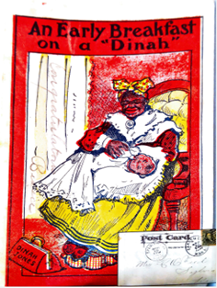 The Mammy stereotype and its prototypes were devices used to demean the African American population throughout the Jim Crow Era. Missy n’ Mammy represented these devices, revealing the influence of visual culture, peers, and the Appalachian Craft Revival on the Swedish identity of Anna Ernberg. Missy n’ Mammy ignored the struggles that black domestic workers, and later their granddaughters, faced, perpetuating female class differences, Lost cause doctrine, and colonial art preservation. The doll signified Ernberg’s dilemma caused by her adaptation to visual culture and the Appalachian Craft Revival, where her capitalist and colonial-art preservation ambitions clashed against her feminist efforts. Conversely, this adaptation resulted in Ernberg’s role as a contributor to the Appalachian Craft Revival and visual culture. Therefore, even though the influence of visual culture and Appalachian Culture seems to absolve Anna Ernberg from her participation in black female minstrelsy, her Swedish background enabled this influence, resulting in the debasement of African American culture and the questioning of her feminist efforts.
The Mammy stereotype and its prototypes were devices used to demean the African American population throughout the Jim Crow Era. Missy n’ Mammy represented these devices, revealing the influence of visual culture, peers, and the Appalachian Craft Revival on the Swedish identity of Anna Ernberg. Missy n’ Mammy ignored the struggles that black domestic workers, and later their granddaughters, faced, perpetuating female class differences, Lost cause doctrine, and colonial art preservation. The doll signified Ernberg’s dilemma caused by her adaptation to visual culture and the Appalachian Craft Revival, where her capitalist and colonial-art preservation ambitions clashed against her feminist efforts. Conversely, this adaptation resulted in Ernberg’s role as a contributor to the Appalachian Craft Revival and visual culture. Therefore, even though the influence of visual culture and Appalachian Culture seems to absolve Anna Ernberg from her participation in black female minstrelsy, her Swedish background enabled this influence, resulting in the debasement of African American culture and the questioning of her feminist efforts.
Bibliography
Adams, Ellen. “Tales from the collection at the Alice T. Miner Museum: ‘From Kentucky to Chazy: Anna Ernberg and the Berea Fireside Industries’.” Alice T. Miner Museum, 2016. March 24, 2020. http://minermuseum.blogspot.com/2016/03/from-kentucky-to-chazy-anna-ernberg-and.html.
Alvic, Philis. “Berea College and Fireside Industries.” In Weavers of the Southern Highlands, edited by University Press of Kentucky 35-55. Lexington, Kentucky: University Press of Kentucky, 2003.
[Item 19/ Folder 10/ Series 4, Box 1], RG 5.28: Belknap Carrol to Berea College Student Industries, 5 June 1933. Needlecraft-Report and Correspondence, Price lists, Labels, 1. Berea: Administrative Divisions: Student Industries, Berea College Special Collections and Archives, 2018.
[Item 11/ Ernberg/ Box 21], RG 09/9.00: Broomfield, Sarah. Anna Ernberg: Appalachian Crafts Revival Artist/ Swedish Artist (WST/HIS 155). Berea: Berea Special Collections and Archives, 2016.
[Item 8/Ernberg/Box 21], RG 09/9.00: Ernberg, Anna. An appeal to the women of America. Berea: Berea College Special Collections and Archives, 2016.
[Item 16/Ernberg/Box 21], RG 09/9.00: Ernberg, Anna. They have eyes and see not, and ears and hear not. Berea: Berea College Special Collections and Archives, 2016.
[Item 24/Ernberg/Box 21], RG 09/9.00: Ernberg, Anna. Ruskin’s ideal for humble homes. Berea: Berea College Special Collections and Archives, 2016.
[ SC-CT-845-018], Evans Ellen, Smith Julia, interviewed by Phillis Alvic. Berea Weaving Oral History Collection. Berea College Special Collections & Archives, April 12, 1995.
Grieve, Victoria M. “Work That Satisfies the Creative Instinct.” Eleanor Roosevelt and the Arts and Crafts.” Winterthur Portfolio 42, no. 2/3 (2008): 159-82. Accessed March 8, 2020. DOI:10.1086/589595.
[Item 24/Ernberg/Box 21], RG 09/9.00: Faculty and Staff Records: Marzolf, Marion. They came, they saw, they wove, Berea College Special Collections and Archives, Berea, Ky. 2016
McDaniel, Hattie. Interview by Wings over Jordan. “Speech for Sunday, July 7, 1940 broadcast of Wings Over Jordan for Miss Hattie McDaniel, Los Angeles California/Negro Star of Gone with the Wind and winner of the 1939 Academy Motion Picture Award for the best-supporting actress.” Wings over Jordan. July 7, 1940. Quoted in Micki McElya, “CONFRONTING THE MAMMY PROBLEM,” in Clinging to Mammy: The Faithful Slave in Twentieth-Century America, Cambridge, Massachusetts: London, England: Harvard University Press, 2007. www.jstor.org/stable/j.ctvjf9z8t.10
McElya, Micki. “CONFRONTING THE MAMMY PROBLEM.” In Clinging to Mammy: The Faithful Slave in Twentieth-Century America, 207-52. Cambridge, Massachusetts; London, England: Harvard University Press, 2007. Accessed March 5, 2020. www.jstor.org/stable/j.ctvjf9z8t.10.
Missy n’ Mammy Doll: 1930-; 2018.35.1, Appalachian Studies Technology Collection, Berea College, Berea, Kentucky.
[Item 23 /Ernberg/Box 21], RG 09/9.00: Faculty and Staff Records: Nadja. “I, A Swedish Immigrant. Make American more American.” Stockholms Tidningen. Translated by Marion Marzolf and Elisabet Lindqvist, December 9, 1931. Berea College Special Collections and Archives, Berea, Ky.
[Item 25/ Folder 11/ Series 4, Box 1], RG 5.28: “Needlecraft of Berea College Student Industries, Cuddle Toys… for Little Folks!! Other Clever Needle Products.” Berea: Administrative Divisions: Student Industries, Berea Special Collections and Archives, 2018.
[Item 29/ Folder 11/ Series 4, Box 1], RG 05/5.28: Needlecraft of Berea College Student Industries, Cuddle Toys… for Little Folks!! Other Clever Needle Products. Berea: Berea Special Collections and Archives, 2018.
Petty, Miriam J. “Hattie McDaniel: ‘Landmark of an Era.’” In Stealing the Show: African American Performers and Audiences in 1930s Hollywood, 27-71. Oakland: University of California Press, 2016. Accessed March 23, 2020. www.jstor.org/stable/10.1525/j.ctt19qggrs.6.
Pilgrim, David. “The Mammy Caricature.” Jim Crow Museum of Racist Memorabilia. Ferris State University. 2012, April 9, 2020, https://www.ferris.edu/jimcrow/mammies/.
Quisenberry, Rosetta. “Aunt Jemima.” A Saga of the Black Woman Part 2, Arturo Alonzo, Cover page. Lexington, KY: Host Communication, 2003.
Quisenberry, Rosetta. “An Early Breakfast on a Dinah.” A Saga of the Black Woman Part 2, Arturo Alonzo, Cover page. Lexington, KY: Host Communication, 2003.
Reef, Catherine. “The Youth of a New Nation:1790-1850” in Childhood in America, 1-24. New York: Facts on File. Inc, 2002.
Sibande, Mary. Interview by the British Museum. A Reversed Retrogress: Mary Sibande. YouTube, Nov 25, 2016. https://www.youtube.com/watch?v=8C5YHIOHqus&t=17s
Seidel, Kathryn. “The Southern Belle as an Antebellum Ideal.” In The Past Is Not Dead: Essays from The Southern Quarterly. Edited by Douglas Chambers, Kenneth Watson, Prenshaw Whitman, Alexander Walker, Alfred Bendixen, David Berry, and Augustus Burns et al. Jackson: University Press of Mississippi, 2012. Accessed April 29, 2020. DOI:10.2307/j.ctt24hxzz.11.
[Item 8 /Ernberg/Box 21], RG 09/9.00: Faculty and Staff Records: “Revives Colonial Industry in Mountain of Kentucky.” Unidentified newspaper. 24 March 1915. Berea College Special Collection and Archives. Berea College Special Collections and Archives, Berea, Ky.
[Item 10/ Folder 13A/ Series 6.1, Box 1], RG 5.28: Vaughn Marshall to President Frost, 23 April 1920. Fireside Industries: Correspondence, Other Regarding Personnel, hiring at Fireside Industries by Anna Ernberg. Berea College Special Collections and Archives, 2018, 1.
Williams, Isadora, “Miss Isadora Williams Honored for Citizenship.” Highland Highlights, Feb 16, 1965. Quoted in Jane S. Becker, “The Southern Highland Handicraft Guild,” in Selling Tradition, Chapel Hill: University of North Carolina Press, 1998, 76-77.
Williams, David. “Lost Cause Religion.” In The Civil War in Georgia: A New Georgia Encyclopedia Companion, edited by Inscoe John C., 194-97. University of Georgia Press, 2011. Accessed April 19, 2020. www.jstor.org/stable/j.ctt46nb3c.45.
Wilson, Shannon, William Goodell Frost: Race and Region. Berea College Special Collections and Archives. 2017, March 20, 2020. https://libraryguides.berea.edu/frostessay.
Wolfskill, Phoebe. “Caricature and the New Negro in the Work of Archibald Motley Jr. and Palmer Hayden.” The Art Bulletin 91, no. 3 (2009): 343-65. Accessed March 5, 2020. www.jstor.org/stable/40645511
Woodson, Carter. “The Negro Washerwomen, A Vanishing Figure.” FNH 15, no. 3. July 1930. Quoted in McElya, Micki. “CONFRONTING THE MAMMY PROBLEM.” In Clinging to Mammy: The Faithful Slave in Twentieth-Century America, 207-52. Cambridge, Massachusetts; London, England: Harvard University Press, 2007. Accessed March 5, 2020. www.jstor.org/stable/j.ctvjf9z8t.10.
Most of the primary sources related to Anna Ernberg and the Weaving Department at the time were supplied by the Hutchins Library’s Special Collections & Archives.